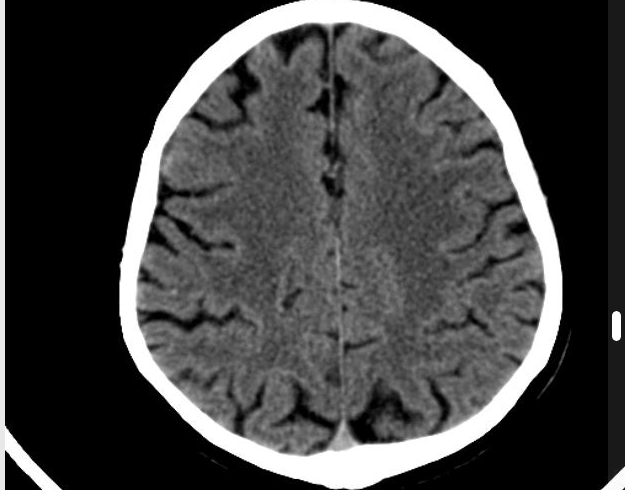WBR0894
| Author | [[PageAuthor::Ayokunle Olubaniyi, M.B,B.S [1]]] |
|---|---|
| Exam Type | ExamType::USMLE Step 2 CK |
| Main Category | MainCategory::Internal medicine |
| Sub Category | SubCategory::Neurology |
| Prompt | [[Prompt::A 65-year-old woman with a past medical history of hypertension, osteoarthritis, and diabetes is brought to the ED with an acute onset of impaired speech, right-sided hemiplegia, and right-sided facial palsy. She also complains of headache and dizziness. She suddenly noticed that she was unable to use her right arm and leg. No history of trauma. She is on hydrochlorothiazide, lisinopril and pravastatin. Her vitals reveals a blood pressure of 158/89 mmHg, heart rate of 85 beats per minute, respiratory rate of 16 breaths per minute, and she is saturating at 98%, while breathing room air. Examination reveals an elderly woman, conscious and alert, not in any obvious painful distress. Lungs and cardiac were auscultations are unremarkable. Abdomen was non-tender, non-distended and without any hepatosplenomegaly. Neurological examination confirms the presenting complaints above. An immediate non-contrast CT of the brain was ordered, and the image is shown below:
|
| Answer A | AnswerA::Subarachnoid hemorrhage |
| Answer A Explanation | [[AnswerAExp::Subarachnoid hemorrhage appears as a high-attenuating, amorphous substance that fills the normally dark CSF-filled subarachnoid spaces. This is most evident in the largest subarachnoid spaces, such as the suprasellar cistern and Sylvian fissures.]] |
| Answer B | AnswerB::Acute ischemic stroke |
| Answer B Explanation | [[AnswerBExp::Typical changes observed after an ischemic infarct may not be evident during the early hours following onset of symptoms of stroke. Some of the subtle changes seen are loss of gray-white differentiation and swelling of the gyri that produces sulcal effacement.]] |
| Answer C | AnswerC::Acute intracerebral hemorrhage |
| Answer C Explanation | AnswerCExp::Acute hemorrhage is evident as areas of hyperdensity on CT (darker than the surrounding brain parenchyma) and areas of hypointensity on MRI. |
| Answer D | AnswerD::Chronic ischemic stroke |
| Answer D Explanation | AnswerDExp::This will be evident as areas of hypodensity on CT. |
| Answer E | AnswerE::Chronic intracerebral hemorrhage |
| Answer E Explanation | AnswerEExp::This manifests as areas of hyperdensity on CT. |
| Right Answer | RightAnswer::B |
| Explanation | [[Explanation::The image above shows loss of gray-white differentiation, one of the subtle changes appreciable very early after an infarct. Another feature of an ischemic infarct is the swelling of the gyri that produces sulcal effacement (not appreciable in this image).
Non-contrast enhanced CT (NCCT) is the preferred immediate brain imaging to rule out or confirm hemorrhage in cases of suspected stroke, especially in the acute setting. Areas of hemorrhage on NCCT appear lighter (hypodensity) while areas of infarct are usually darker (hyperdense). Educational Objective: NCCT is used to rule out hemorrhage during an acute stroke. It is important to know how to differentiate a bleed from ischemic areas on a CT or MRI. |
| Approved | Approved::No |
| Keyword | WBRKeyword::Stroke, WBRKeyword::Acute ischemic stroke, WBRKeyword::diagnosis of stroke |
| Linked Question | Linked:: |
| Order in Linked Questions | LinkedOrder:: |
